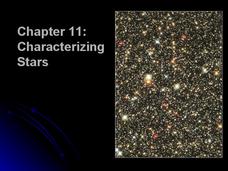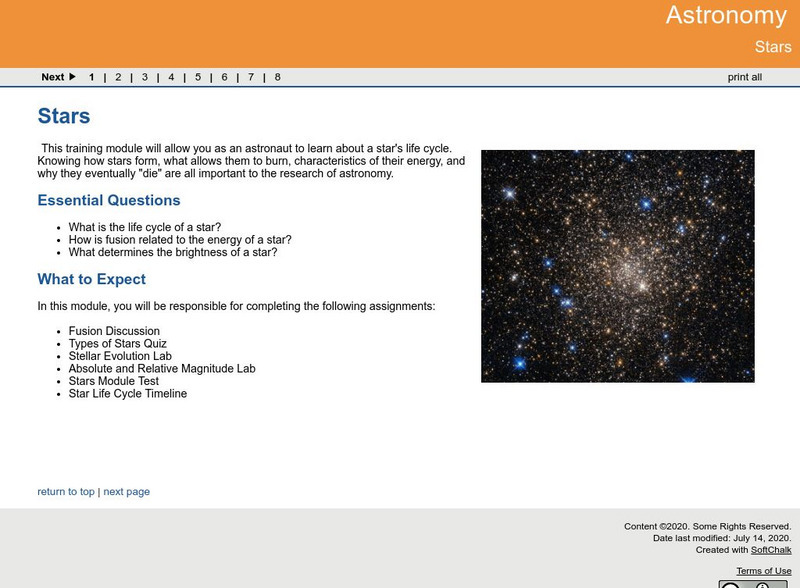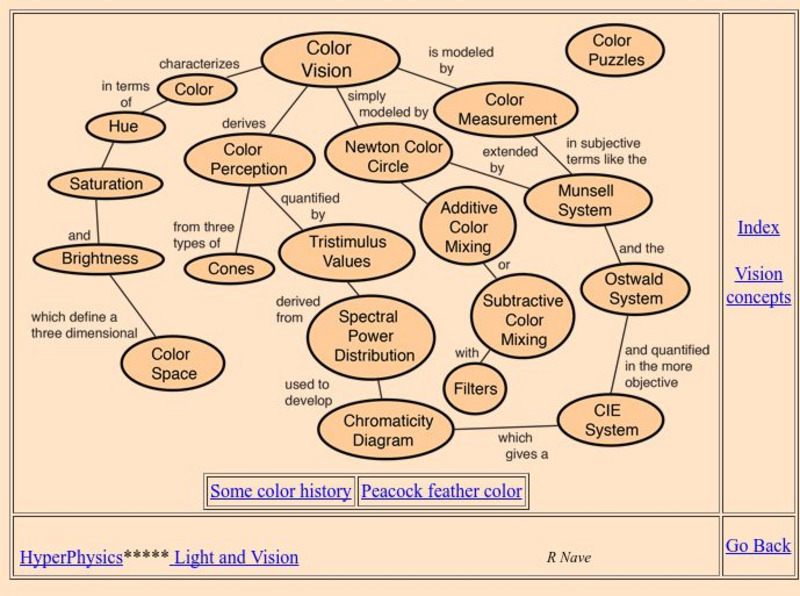Curated OER
How Big Is That Star?
Aspiring astronomers study stars. They compare stars and explain the relationship between radius, mass, and diameter. By creating a star simulation, they discover how a binary star system's orbit can cause changes in the observed...
Glynn County School System
Characterizing Stars
Are brighter stars actually brighter? Turns out they are probably just closer! A presentation compares features of stars to our favorite star, the sun. In addition, solar lovers learn to classify stars based on their masses,...
Laboratory for Atmospheric and Space Physics
Star Light, Star Bright
Star light, star bright, first star I see ... wait a minute, where did the star go? Scholars complete a simulation that measures the brightness of a distant star as another object passes in front of it. Learners move the passing object...
Curated OER
Physics 152 Fall 2004 Final Exam, Parts A, B, C, D
At the end of a general physics course focused on light and electricity, you can administer this exam. Concepts covered include electromagnetism, circuits, induction, light rays, lenses and mirrors, characteristics of light, electron...
Curated OER
The Hertzsprung-Russell Diagram
In this astronomy worksheet, students use a Hertzsprung-Russell diagram to examine the relationship between the average temperatures of stars and their absolute magnitude. After viewing the diagram, they complete 10 short answer questions.
Curated OER
Star Frames
Fourth graders study constellations. For this space science lesson, 4th graders discover what makes stars, how bright stars are, and why constellations were created. Students make their own constellation using Saran Wrap and a frame.
Curated OER
Light and Shadows
Students explore shadows. In this shadow and light lesson, students predict what will happen to a shadow when the light source is dimmed. Students participate in a whiteboard interactive lesson.
Curated OER
Intensity of Light
Students discover the relationship between the brightness of a light and the distance from the light. They identify two different ways of looking at the brightness of a light, how luminous light is and how illuminated an object is....
Georgia Department of Education
Ga Virtual Learning: Stars
In this interactive module students will explore the life cycle of stars and how they produce energy.
Georgia State University
Georgia State University: Hyper Physics: Color
This site from Georgia State University discusses the location of visible light on the electromagnetic spectrum. Includes the wavelength values for various colors of light within the visible light spectrum.
Georgia State University
Georgia State University: Hyper Physics: Characterizing Color
This site from Georgia State University discusses the meaning of the terms hue, saturation and brightness. Thorough, meaningful explanations and outstanding graphics.
Georgia State University
Georgia State University: Hyper Physics: Color Vision Concepts
An indexing page from Georgia State University for a variety of other pages associated with color vision. Pages are filled with meaningful graphics and thorough explanations.
University of Colorado
University of Colorado: Physics 2000: Temperature and Absolute Zero
A thorough, multipage discussion of color and color television sets that explains how an image is formed on the television using red, green, and blue light. Understandable discussion, excellent graphics, and many interactive Java applets.
The Tech Interactive
Tech Museum of Innovation: Brightness
After defining brightness in relation to the strength of a color, this site an example as well as an activity entitled, "Experimenting with Brightness."
The Tech Interactive
Tech Museum of Innovation: Color
This section of the Tech Museum of Innovation on color is divided into sections including hue, saturation, brightness, and go wild. Each section includes information as well as learning activities.
The Tech Interactive
Tech Museum of Innovation: Brightness/saturation/hue
This site combines the elements of brightness, hue, and saturation to see differences in color in the things around us. Each element is dealt with individually and is incorporated into an activity involving all three.
ArtLex
Art Lex: Color
An in-depth instructional page on color that defines a variety of terms related to color.














